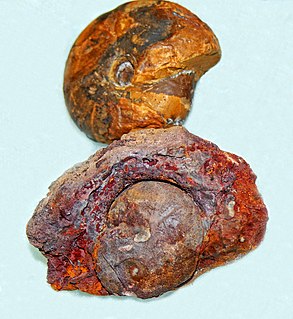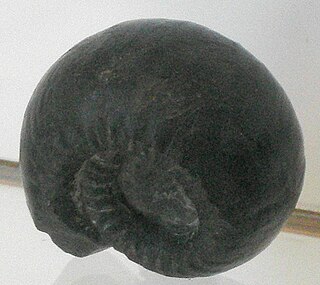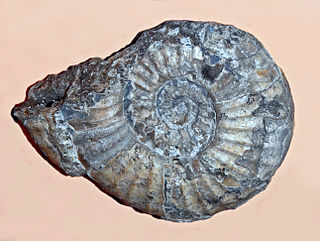Related Research Articles
Arkanites is a goniatitid ammonite that lived during the Early Pennsylvanian that has been found in Arkansas and Oklahoma in the U.S.
Baschkirites is an extinct cephalopod genus belonging to the ammonoid order Goniatitida that lived during the Early Carboniferous (Bashkirian).
Donetzoceras is a genus belonging to the goniatitid family Gonioglyphioceratidae ; extinct ammonoids which are shelled cephalopods more closely related to squid, octopus and other coleoids than to the superficially similar Nautilus
Beyrichoceras is a genus belonging to the goniatitid family Muensteroceratidae, a group of ammonoids, extinct shelled cephalopods related to belemnites and recent coleoids and more distantly to the nautiloids

Beyrichoceras is a genus belonging to the goniatitid family Maxigoniatitidae that lived during the Mississippian Period

Gastrioceratoidea is one of 17 superfamilies in the suborder Goniatitina, ammonoid cephalopods from the Late Paleozoic.
The Cravenoceratidae is one of six families included in the ammonoid superfamily Neoglyphioceratoidea, which lived during the latter part of the Paleozoic era.

Psiloceratoidea is a superfamily of Early Jurassic ammonoid cephalopods proposed by Hyatt in 1867, assigned to the order Ammonitida. They were very successful during Hettangian and Sinemurian. Last of them, family Cymbitidae and genera Hypoxynoticeras and Radstockiceras survived into Early Pliensbachian.
Prolecanitida is an order of extinct ammonoid cephalopods with discoidal to thinly lenticular shells with goniatitic or ceratitic sutures and which retained the simple retrochoanitic siphuncle with backward extending septal necks. As typical for ammonoids the siphuncle is along the ventral margin. Prolecanitids form a relatively small and stable order within the Ammonoidea with 43 named genera and about 1250 species, but with a long-ranging lineage of about 108 m.y. stretching from the Lower Carboniferous to the Triassic. Although not as diverse as their goniatitid contemporaries, the Prolecanatida provided the stock from which all later Mesozoic ammonoids were derived.
Siberionautilidae is a family in the nautilid superfamily Clydonautiloidea that contains only the genus Siberionautilus, which comes from the Upper Triassic (Carnian) of Siberia, Russia.

Metacoceras is a nautilitoid cephalopod from the Upper Carboniferous (Pennsylvanian) and Permian, the shell of which is moderately evolute with a subquadrate whorl section, bearing nodes on the ventral or umbilical shoulders or both, but otherwise smooth. The siphuncle is small, subcentral and orthochoanitic. The suture has shallow ventral and lateral lobes but no dorsal or annular lobe.
Neoaganides is a small, 1–2 cm diameter subdiscoidal to subglobular goniatitid belonging to the family Pseudohaloritidae that lived from the Late Pennsylvanian to the Late Permian, existing for some 56 million years.
The Uddenitinae a subfamily of the Medlicottiidae, a family of ammonoid cephalopods included in the Prolecanitida. The Uddenitinae, proposed by Miller and Furnish, and known from the Pennsylvanian and Lower Permian, are transitional between the ancestral Pronoritidae and the more traditional medlicottiids
Biloclymenia is a genus in the ammonoid order Clymeniida which is characterized by a dorsal retrosiphonitic siphuncle with long adapically pointing septal necks.
Neoglaphyrites is a gonititid ammonite that lived during the latest Pennsylvanian and early Permian. Its shell is ellipsoidal and moderately involute; the umbilicus deep and typically less than 15 per cent of the shell diameter but in some species closer to 20 per cent. Delicate growth lines forming ventral and lateral sinuses and ventrolateral and dorsolateral salients have been found on Canadian Arctic specimens. The suture is characterized by the ventral lobe split into two broad prongs that are separated by a high median ventral saddle; prongs closely approximate the width of the first lateral lobe. The first lateral saddle is evenly rounded and is nearly symmetrical. The umbilical lobe is V-shaped and internal lobes are deep and narrow.
Darvasiceras was a prolecanitid ammonoid cephalopod from the Early or Lower Permian Chelamchin Formation of Tajikistan. The genus is included in what is now the superfamily Medlicottioidea. The type species is Darvisciceras minum.
Masonoceras is a genus of Karagondoceratids from Lower Mississippian strata, the shell of which is thinly subdiscoidal to discoidal with an acute ventral margin in late ontogeny. Whorls are strongly embracing, umbilicus narrow to occluded. The mature external suture contains a wide trifid ventral lobe, the flanking prongs longer that the medial, an asymmetrically rounded lateral saddle and a deeper asymmetric pointed lateral lobe. Internal molds of the type, Mesoceras Kentuckiense show presence of a broad hyponomic sinus flanked by high rounded vantrolateral salients.
Quinnites is a genus of gonititid ammonites included in the gastrioceratoidean family Reticuloceratidae known from the Carboniferous of the state of Arkansas, USA.
Branneroceras is a goniatitid genus from the Late Carboniferous. Their fossils have been found in Nunavut, Canada, and in Arkansas and Texas, USA.
Gastrioceras is a goniatitid genus in the family Gastrioceratidae that lived during the late Carboniferous (Pennsylvanian and for most of the Permian.